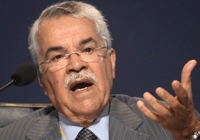
Ali Al-Naimi at the Opec meeting.
Image: Reuters
Saudi Arabia under pressure on oil price
Vienna, June 13, 2012
Saudi Arabia came under pressure on Wednesday from fellow Organization of the Petroleum Exporting Countries (Opec) producers to cut oil output to prevent a further slide in crude prices.
Price hawks in Opec are fretting that slowing economic growth will send crude, already off $30 since March, plummeting further.
'We think that given the economic situation, above all in Europe, there is a serious threat that prices might fall drastically and so our policy is to defend the production ceiling agreed in December of 30 million barrels a day,' said Venezuelan Oil Minister Rafael Ramirez.
'I am afraid of this fall, anything below $100 is very painful for Libya,' said Libyan Oil Minister Abdulrahman Ben Yazza. Brent crude traded at just over $97 a barrel on Wednesday having peaked this year at $128 in March.
A moderate on oil prices, Saudi Arabia's Oli Minister Ali Al-Naimi initially floated a proposal to lift Opec's output target. After Saudi Arabia quickly dropped that idea, the 12-member group looks set at a Thursday meeting to leave its formal production ceiling unchanged at 30 million barrels daily.
But extra oil from Saudi boosted actual output to 31.6 million bpd in May, a production rate in excess of demand that is building world inventories rapidly.
A report from Opec estimated inventories rose by 2.1 million bpd on average in the first quarter of the year during a seasonal period when stocks normally decline. Supply and demand data suggests a build on a similar scale in the second quarter.
'In the face of such gloomy uncertainty Opec should be discussing production restraint on Thursday,' said David Hufton of London oil brokers PVM.
Saudi Arabia, the world's only major swing producer, finds itself in the tricky position of trying to plan cover for supplies lost from Iran when an European Union oil embargo starts on July 1 without sending prices crashing.
Its preferred oil price is $100 a barrel, a price it feels permits oil investment without hurting economic growth, while most in Opec want to defend $100 as a price floor.
Extra Saudi supply, taking Riyadh to a 30-year high of 10 million bpd, has helped build oil stocks around the world. In the United States, where Saudi crude imports have risen sharply this year after years of decline, crude stocks are at their highest since 1990.
The stock cover will provide insurance against further the output losses from Iran, where the International Energy Agency estimates exports are already down 40 percent, 1 million barrels daily, to 1.5 million bpd since the end of last year.
Asian importers of Iranian crude had been hoping that part of the EU embargo on Iran, on shipping insurance, might be delayed or cancelled to permit them to continue taking out UK indemnity to cover Iranian oil shipments.
But EU Energy Commissioner Guenther Oettinger said on Wednesday the embargo would proceed as planned.
Those in Opec who fear a price slide can cite the group's own in-house analysis from its Vienna secretariat which suggest prospects for oil demand are darkening.
'From the Euro-zone crisis to a notable deceleration in the developing and emerging economies, the current challenges are manifold,' the secretariat said in a report this week.
'The second half of the year could see a further easing in fundamentals, despite seasonally higher demand.'
Even Saudi Arabia's closest Gulf allies are showing signs of discomfort at the decline in prices. 'A little bit much,' was UAE Oil Minister Mohammed Al-Hamli's verdict on supplies. - Reuters







